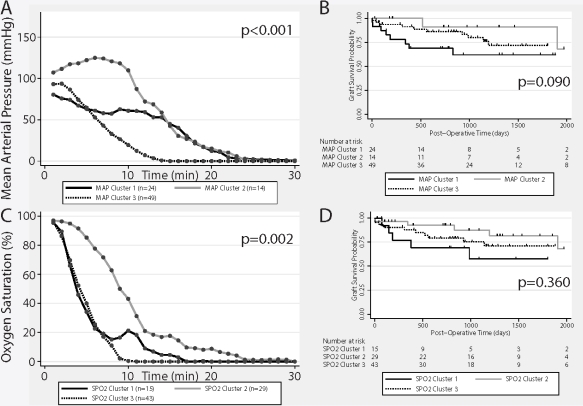Role of Donor Hemodynamic Trajectory in Determining Graft Survival in Liver Transplantation from Donation After Circulatory Death Donors.
Cleveland Clinic, Cleveland.
Meeting: 2016 American Transplant Congress
Abstract number: B248
Keywords: Cadaveric organs, Donors, Hemodynamics, Liver transplantation, non-heart-beating
Session Information
Session Name: Poster Session B: Liver: MELD, Allocation and Donor Issues (DCD/ECD)
Session Type: Poster Session
Date: Sunday, June 12, 2016
Session Time: 6:00pm-7:00pm
 Presentation Time: 6:00pm-7:00pm
Presentation Time: 6:00pm-7:00pm
Location: Halls C&D
This retrospective study of 87 donation after circulatory death (DCD) liver transplants from 2007-2015 tested the hypothesis that donor hemodynamic trajectory following withdrawal effects graft survival, distinctly from donor warm time. The donor shortage increases waiting list morbidity and mortality and despite their controversial application, the only short term solution is extended criteria donors, including DCD. We collected donor and recipient records from UNOS' Donornet and our prospectively collected transplant database, respectively. There was a high degree of heterogeneity of donor course across, withdrawal time, mean arterial pressure (MAP), oxygen saturation (SPO2), and pulse. Clustering analysis on MAP, SPO2, and pulse was used to explore the hemodynamics data. Combining clinical judgment with that pilot, we identified 3 distinct donor phenotypes; rapid decliners (C3, n=49), donors with long withdrawal and poor hemodynamics (C1, n=24), and donors with long withdrawal and nearer-physiologic hemodynamics (C2; n=14). Overall, results were acceptable and similar to other reports; 5-year graft survival of 72.1%. 1-, 3-, and 5-year graft survivals for MAP defined, C3 were 91.3%, 86.4%, and 71.7%. 1-, 3-, and 5-year graft survivals for MAP defined, C1, and C2 was 73.5%, 62.0%, and 62.0%, compared with 100.0%, 90.9%, and 90.9%, respectively (p=0.090). Donors across MAP cluster had similar, admission length prior to procurement, vasopressor support, CIT, LDRI, RWIT, laboratory MELD, recipient age and were transplanted in a similar era. C2 donors were younger than C3 and C1 (p=0.029). However graft survival was not associated with donor age (HR=1.00 per year; p=0.884). To test the hypothesis that C2 donors were equivalent to C3 and together, superior to C1, they were combined and compared to C1. Graft survival was clinically and statistically superior for MAP (p=0.038) but not SPO2 (p=0.232) defined C3+C2 clusters. In conclusion, the donor pool can be safely expanded through increased acceptance of livers from donors with extended withdrawal times but who maintain nearer-physiologic perfusion pressures during withdrawal. 
CITATION INFORMATION: Firl D, Hashimoto K, O'Rourke C, Fung J, Eghtesad B. Role of Donor Hemodynamic Trajectory in Determining Graft Survival in Liver Transplantation from Donation After Circulatory Death Donors. Am J Transplant. 2016;16 (suppl 3).
To cite this abstract in AMA style:
Firl D, Hashimoto K, O'Rourke C, Fung J, Eghtesad B. Role of Donor Hemodynamic Trajectory in Determining Graft Survival in Liver Transplantation from Donation After Circulatory Death Donors. [abstract]. Am J Transplant. 2016; 16 (suppl 3). https://atcmeetingabstracts.com/abstract/role-of-donor-hemodynamic-trajectory-in-determining-graft-survival-in-liver-transplantation-from-donation-after-circulatory-death-donors/. Accessed July 12, 2025.« Back to 2016 American Transplant Congress
